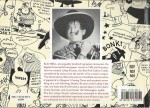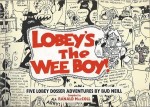

By Bud Neill, compiled by Ranald MacColl (Mainstream Publishing)
ISBN: 1-85158-405-6
Nobody’s ever accused me of being sensitive to the tone of the times, but with all thoughts directed north of the border for so long now, I’ve decided to feature this superbly unique dose of Celtic (more properly Glaswegian) cartoon magic today.
It’s the work of a tragically near-forgotten genius of pen and brush who should rightly be a household name wherever people like to laugh and ponder the absurdity of existence, no matter what flag they fly.
William Neill – forever immortalised as “Bud†– was born in 1911 in Partick just before the family moved to Troon in Ayrshire. He was a typical kid and fell in love with the brash wonder of silent movies – most especially the rambunctious westerns of William S. Hart.
His other great drive was a love of horses, and he could always be found hanging around stables, trading odd jobs for the chance of a few minutes’ riding.
After finishing school the young artistic star won a place at Glasgow School of Art. In the late 1930s Bud briefly emigrated, working in Canada and absorbing the tricks of America’s greatest newspaper cartoonists in their creative heyday.
He served as a gunner during WWII but was invalided out and became a bus driver. These experiences led to his creating a series of pocket cartoons starring the “Caurs & Clippies†of Glasgow’s tramcar system.
By 1944 Bud was drawing for the Glasgow Evening Times: sharp, wry observational pieces starring the city and its inhabitants, characterised by a devastating and instantly enchanting use of the iconic rhythms, vernacular and argot everyone shared.
In January 1949 The Evening News began running the uniquely surreal escapades of his greatest creation. Sheriff Lobey Dosser of Calton Creek was a brilliant inspiration: the adventures of a canny wee lawman in a hauntingly typical western town populated exclusively by Scots (from Glasgow’s Calton district, presumably) living an outrageously domestic, hilariously apt inner city life all whilst tricked out in cowboy hats and six-guns…
Delving deep into the venerable, anarchic and often surreal material of music hall and pantomime, Bud crafted a supremely odd, anachronistically familiar, bizarrely inviting world of solecism masquerading as local events. The series transferred to The Sunday Mail in 1956 where it became so popular that previous, complete strip adventures were collected in instant sell-out, one shilling landscape booklets (all incredibly sought after collectors’ items these days).
Neill died in 1970 but his work steadily continued to garner fans and acquire a mythical status, so by the middle of the decade Glasgow artist and sculptor Ranald MacColl began work on a biography.
That in turn led to a series of graphic collections such as this one and eventually belated recognition for Neill and his most memorable creations.
Bud was subsequently celebrated in exhibitions, galleries and, following Glasgow’s becoming European City of Culture in 1990, two separate bronze statues (Lobey, Rank Bajin and noble steed Elfie in Woodlands Road and, in Homecoming Year 2009, The G.I. Bride and her “Wean†at Partick Station), funded by public donations, Strathclyde Passenger Transport and private sponsors.
Hard to find but so worth the effort, Lobey’s The Wee Boy! gathers the contents of five of those shilling collections in a sensibly narrative chronological – not publication or even creation – order and is packed with informative extras such as MacColl’s fascinating historical and atmospheric Introduction and a hilarious Prologue by Bud himself from 1958, before the astonishing origin of the champion of Calton Creek is revealed in ‘Lobey Dosser: His Life Story’.
On a rare quiet day the grizzled sheriff recounts his early life to a jail full of impressionable young’uns…
Once upon a time in auld Glesca a mother had one bairn too many and the precocious tyke, to spare her further hardship, put his possessions in a hanky on a stick and headed off to make his way in the world.
Although only a few months old, he rejected being fostered out to his mean Auntie Mabel and joined a merchant ship under the tyrannical Captain Blackswite, unaware that the big shouty blackguard was a pirate…
After many exciting years at sea Lobey jumped ship and was befriended by cannibals and their erudite chief Hannibal which led to more exploring, meeting monsters and other strange things before encountering a race of Oxbridge-educated white savages and happily acquiring a rare two-legged horse.
El Fideldo was to become his greatest friend and inseparable companion. Together they made their way to Mexico where the wee wanderer discovered an unsuspected talent for upholding the law and keeping the peace. After cleaning out a nest of vicious banditos the restless pair headed north and soon fetched up in Laredo, Texas where a disastrous love affair with Adoda, formidable daughter of wealthy Whisk E. Glorr, led to a clash with rustlers led by scurrilous Watts Koakin…
His heart broken – even though he had cleaned up the range – Dosser and Elfie kept heading west until they reached Arizona and first met future arch-nemesis Rank Bajin selling out the wagon train he was guiding to the local Sioux…
Rescuing the embattled settlers, Lobey decided to stay with the Scots expats as they built a town in the wilderness. They called it Calton Creek…
Wild, imaginative and with every daily episode loaded with sight gags, striking slapstick, punishing puns, cartoon in-jokes and intoxicating vernacular, each Lobey Dosser tale was a non-stop carnival of graphic mirth and this terrific tome continues in fine fettle with ‘The Mail Robbery’ wherein nefarious Bajin attempts to incite an Indian uprising amongst the Pawnee of Chief Toffy Teeth and leaves the little lawman to die of thirst in the searing deserts. As the scorched sheriff struggles to survive, the naïve citizens are left to adapt to a protective occupation by flash Yankee G.I.s and airmen…
Sardonic and satirically cutting, the yarn also sports one of the best – and daftest – horseback chases in entertainment history…
Romance and mystery abound in ‘The Secret of Hickory Hollow’ as that Bajin scoundrel buys up the mortgage on Vinegar Hill‘s farm and tries to kick out the old coot and his substantial niece Honey Perz. The villain has got wind of a mineral resource on the property that would make a man as wealthy as the Maharaja of Baroda, or perhaps even a regional Deputy Superintendent of the Coal Board…
When Lobey organises the cash needed to pay off the outstanding loan, Bajin reluctantly resorts to the last resort and begins romancing sweet, innocent, hulking Honey…
It all looks bleak for justice until the sheriff befriends an astoundingly good-looking and wholesome uranium prospector named Hart O’Gold who quickly tickles Honey’s fickle fancy…
However nobody – including ghostly guardian Rid Skwerr – is prepared for the soviet spies behind the entire affair to jump in take over and it needs the timely intervention of mystic imp Fairy Nuff to save their accumulated hash before the Dosser can finally expose the viper in the nest…
The local natives are always up to mischief and ‘The Indian War’ kicks off when the railroad tries to lay track through Pawnee Territory just as Chief Rubber Lugs of the Blackfeet Tribe revisits an old and outstanding grudge with Chief Toffy Teeth.
The ineffectual Captain Goodenough arrives with a division of cavalry to safeguard the white citizenry but matters soon worsen, painfully exacerbated when the folk of Calton Creek take advantage of Lobey’s absence (he’s trying to negotiate with both bunches of bellicose braves) to run Rank Bajin out of town and the hooded hoodlum starts freely peddling weapons to both sides…
…And then Bajin kills Lobey and takes over the town.
…And then…
The last yarn in this monochrome tome of tall tales is the most incredible of all as ‘The “Reform†of Rank Bajin’ sees the vile villain scooting around Calton Creek doing good deeds and selling off his astounding arsenal of wicked weapons and cunning contraband. Baffled, perplexed, confused and not sure what’s going on, Lobey asks Boot Hill haunter Rid Skwerr to spy on the no-longer reprehensible Rank and even love-struck Fairy Nuff gets in on the act.
The astounding truth finally emerges: Bajin has a boy who is growing up honest, so he is selling up and returning to the family he deserted in Borstal Bluffs, Iowa to sort the shameful lad out. Knowing the tremendous vacuum his absence will leave in Calton’s exciting landscape, however, he has a recommendation for a locum arch-enemy for his arch-enemy…
Can this possibly all be true or is the beastly Bajin executing his most sinister scheme yet?
Cunningly absurdist, socially aware, humorously harnessed insanity in the manner of Spike Milligan, Michael Bentine and the immortal Goon Show, the adventures of Lobey Dosser are a brilliant example of comic strips perfectly tailored to a specific time, place and audience which magically transcend their origins to become a masterpiece of the art form.
It’s also side-splitting, laugh-out-loud, Irn Bru spit-take hilarious and really needs to be recollected for today’s audiences.
And of course that’s what I really want: a complete reprinting of these sublimely perfect spoofs.
And once you read some so will you…
© Ranald MacColl 1992. All rights reserved.
